By Sandhya Sridhar
Thanjavur or Tanjore is a bustling city of Tamil Nadu with an extremely rich history. What stands out is the very famous Brihadeeswarar temple, a veritable marvel for its astonishing vision and construction.
Less remembered are a few comparatively later day artistic creations, some almost forgotten, a few continuing to thrive.

Let’s take for example the bobblehead Thanjavur bommai, the doll that shakes its head, that’s colloquially referred to as the ‘thalaiatti bommai’. This doll received the Geographical Indication (GI) tag by the Government of India in 2008-09. While it’s ubiquitous in all kolus, as the doll festival is called down South, once upon a time it was that every South Indian showcase had this pair. They would either be a dancer in all her finery appearing very much as if she were practising her art, the poi kal kudirai or a man or woman in the traditional horse dance, or the most popular one—a chubby elderly couple, smiling as they bobbed their heads this way and that. Today, we hardly ever see the dolls so commonly as it used to be.

While the thalaiatti bommai continues to be available on Amazon and a few online outlets, one artefact that has almost vanished is the Thanjavur plate, much treasured as a memento or a gift. Made from silver, copper, bronze and brass, this was a round plate that you could hang on the wall. The depictions would mostly be traditional motifs, mostly gods and goddesses, but sometimes even the annam or the annapakshi motif or elephants. These plates were once treasured by the giver and the recipient.
The Thanjavur plate came in different sizes and was handcrafted, the work being embossed on the base brass plate. This plate, it is said, was the conception of Raja Serfoji II, who wished to create something that would mark his rule for its greatness and majesty. The brass base of the plate would be enhanced by copper and silver work done by a jeweller. The plate was sometimes jewel-encrusted and when this was done, the services of a stone-setter was requisitioned. This plate has a GI tag too, and is popularly known as the Thanjavur Art plate.

The one art form that continues to be popular and much purchased is what is called the Thanjavur painting or the Tanjore painting. This is usually depictions of popular gods and goddesses, with gold foil work and is studded with stones. Initially, the Thanjavur painting was an experimentation inspired by Mughal works that used gold foil. The art form evolved over time, and during Raja Serfoji II’s time, it became established in the form and conception that we see it today. The Tanjore painting continues to be popular as an art form, and can be quite commonly seen in art galleries in the country.
Be it the Cholas or the Thanjavur Marathas, this region has proved to be rich and fertile for the arts, be it the performing ones, or artefacts and sculpture. The last, we can see in abundance in the many temples that dot the region.











Leave a Reply